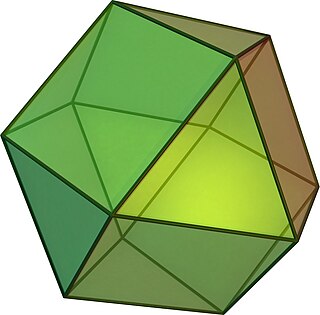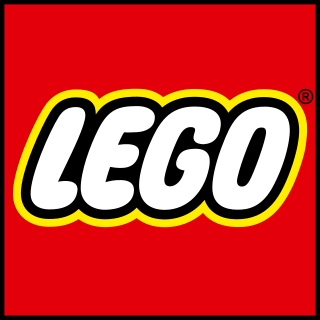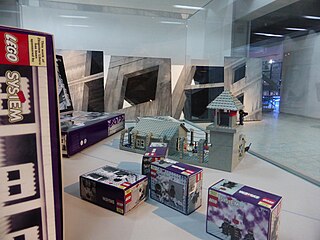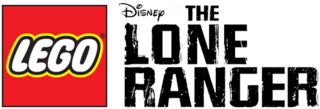
A cuboctahedron is a polyhedron with 8 triangular faces and 6 square faces. A cuboctahedron has 12 identical vertices, with 2 triangles and 2 squares meeting at each, and 24 identical edges, each separating a triangle from a square. As such, it is a quasiregular polyhedron, i.e. an Archimedean solid that is not only vertex-transitive but also edge-transitive. It is radially equilateral.

Lego is a line of plastic construction toys that are manufactured by The Lego Group, a privately held company based in Billund, Denmark. The company's flagship product, Lego, consists of variously colored interlocking plastic bricks accompanying an array of gears, figurines called minifigures, and various other parts. Lego pieces can be assembled and connected in many ways to construct objects, including vehicles, buildings, and working robots. Anything constructed can be taken apart again, and the pieces reused to make new things.
Lego Technic is a line of Lego interconnecting plastic rods and parts. The purpose of this series is to create more advanced models with more complex technical functions, compared to the simpler brick-building properties of normal Lego.

This article lists notable events and releases in the history of the Lego Group.
The history of Lego began in 1932, when Ole Kirk Christiansen founded the company in a Danish carpentry workshop, and continues into the 21st century as a popular and very profitable line of construction toys and related products and services, with a significant impact on various areas of popular culture. Despite its expansion, the company remains privately held.

Zbigniew Libera is a Polish artist, born in Pabianice, Poland. Libera’s artworks are considered to fall under the styles of pop art and critical art, and have been frequently used his works to comment on political and social issues.
Chris Cran is a Canadian visual artist, based in Calgary, Alberta.
Katie Ohe, is a Canadian sculptor living in Calgary, Alberta. Ohe is known as one of the first artists to make abstract sculpture in Alberta, and has been influential as a teacher at the Alberta College of Art and Design. She is best known for her abstract and kinetic sculptures.

Mega Brands Inc. is a Canadian children's toy company currently owned by Mattel. Mega Bloks, a line of construction set toys, is its most popular product. Its other brands include Mega Construx, Mega Puzzles, Board Dudes and Rose Art. The company distributes a wide range of construction toys, puzzles, and craft-based products.

Jessen's icosahedron, sometimes called Jessen's orthogonal icosahedron, is a non-convex polyhedron with the same numbers of vertices, edges, and faces as the regular icosahedron. It is named for Børge Jessen, who studied it in 1967. In 1971, a family of nonconvex polyhedra including this shape was independently discovered and studied by Adrien Douady under the name six-beakedshaddock; later authors have applied variants of this name more specifically to Jessen's icosahedron.
The acknowledgement of Lego in popular culture is demonstrated by the toy's wide representation in publication, television and film, and its common usage in artistic and cultural works.
Kirsten Lillian Abrahamson is a Canadian ceramic artist.

William (Bill) Laing is a Scottish/Canadian artist based in Calgary, Alberta. He is known for his printmaking and sculpture.
Nancy Tousley is a senior art critic, journalist, art writer and independent curator whose practice has included writing for a major daily newspaper, art magazines, and exhibition catalogues.
Judith Schwarz is a Canadian visual artist. Her work has been featured in exhibitions since 1979.
Dulcie Foo Fat is a British-born Canadian landscape painter, based in Calgary, Alberta. Foo Fat is known for her large representational paintings made from her photographs of the microscopic landscape of the forest floor, particularly in the Rocky Mountains, or of the bottoms of tidal pools, that reconcile abstract expressionism and magic realism. They suggest, without stating it, the fragility of the environment.
Joice M. Hall is a Canadian artist from Alberta, now based in British Columbia. She is known primarily as a landscape painter.

Janet Mitchell LL.D was a Canadian modernist painter from Alberta, known for her fantasies of Calgary in watercolours and oils.

John Hall is a Canadian modernist painter from Alberta, known for his highly realistic painting style.

Lego The Lone Ranger was a Lego theme based on the film of the same name. It is licensed from Walt Disney Pictures and Jerry Bruckheimer Films. The theme was first introduced in April 2013 and was discontinued by the end of 2014 in conjunction with the theatrical release of the film.









